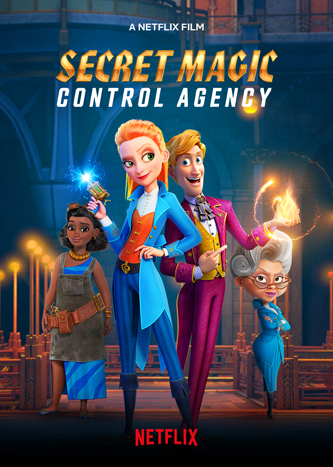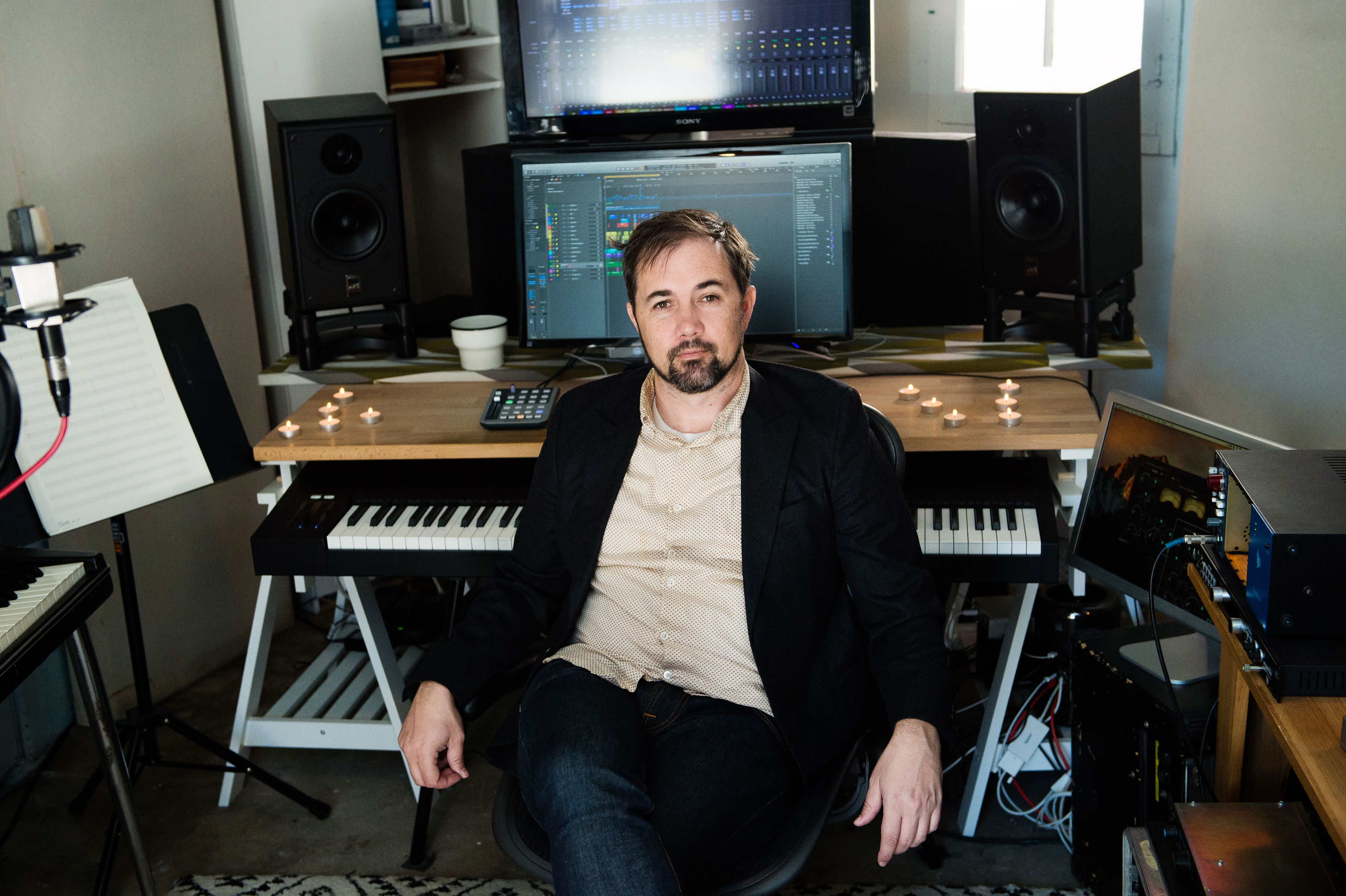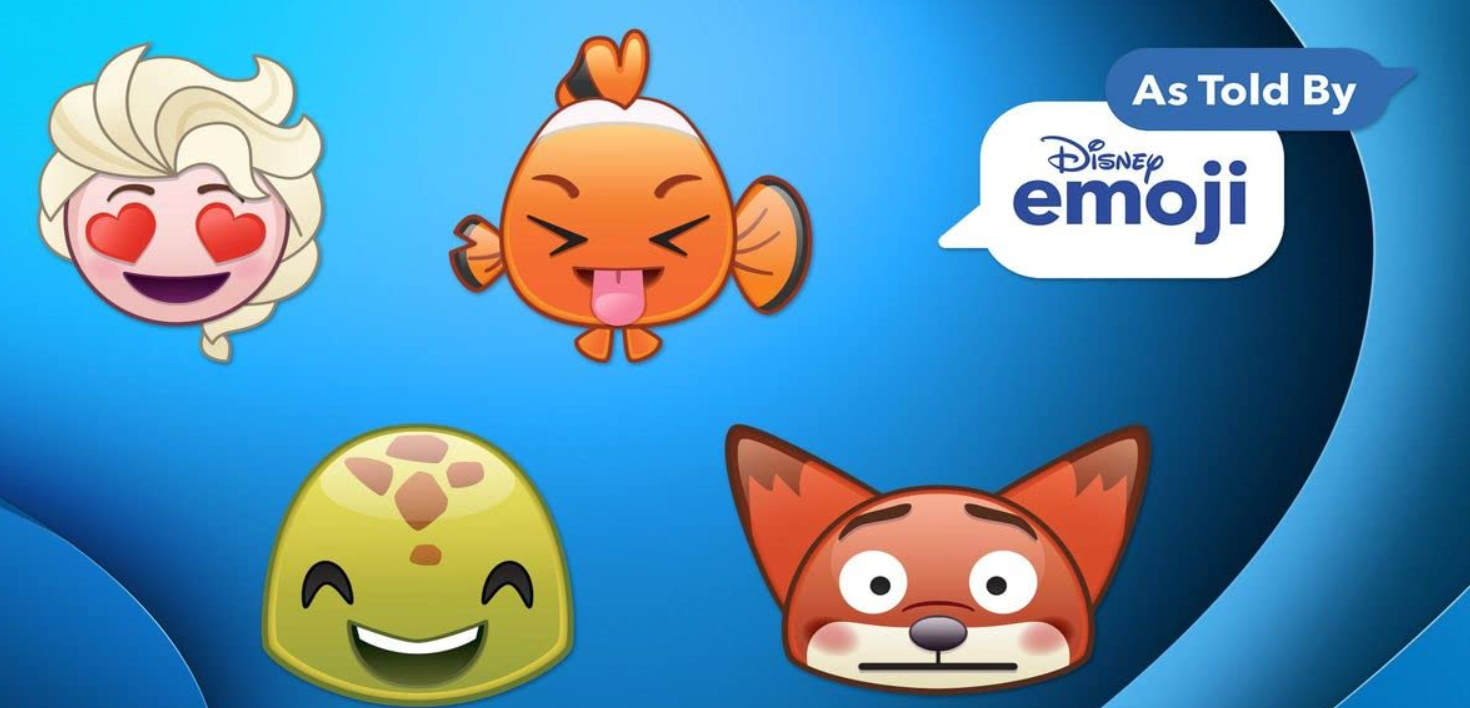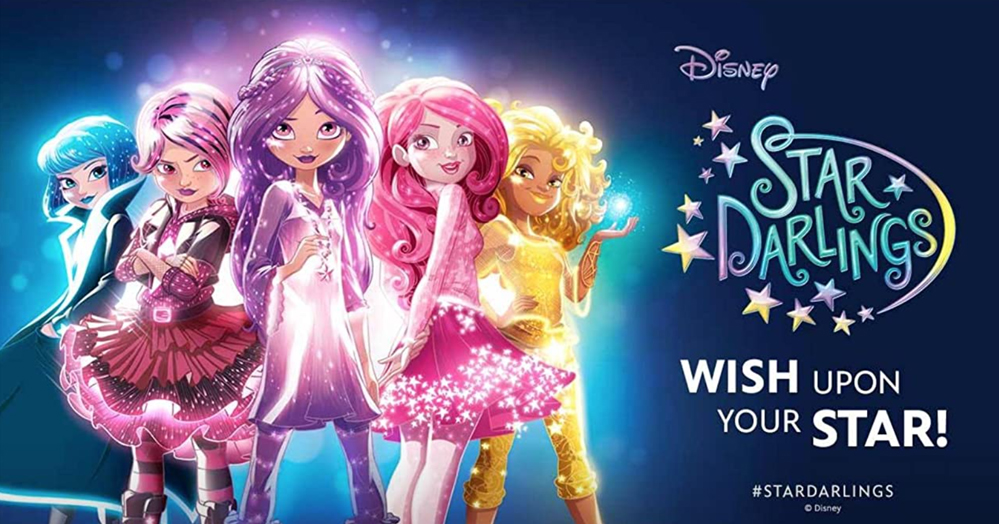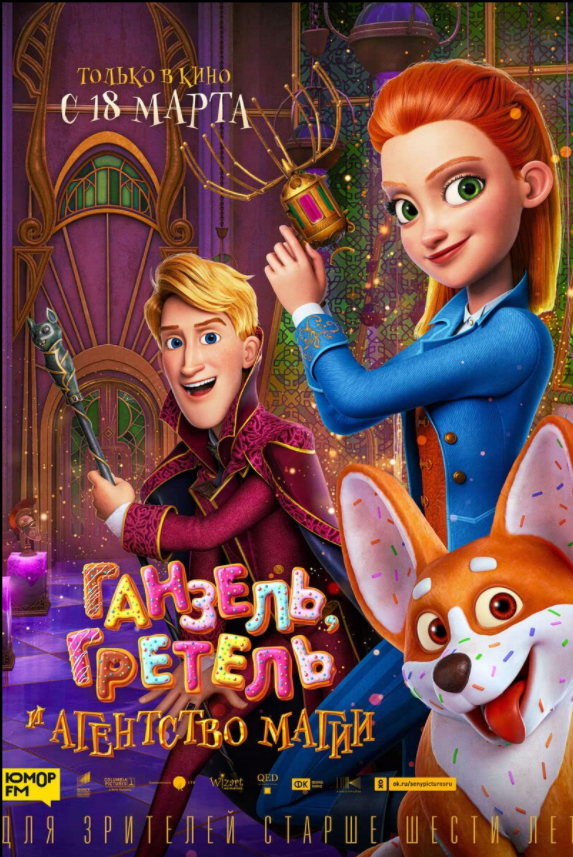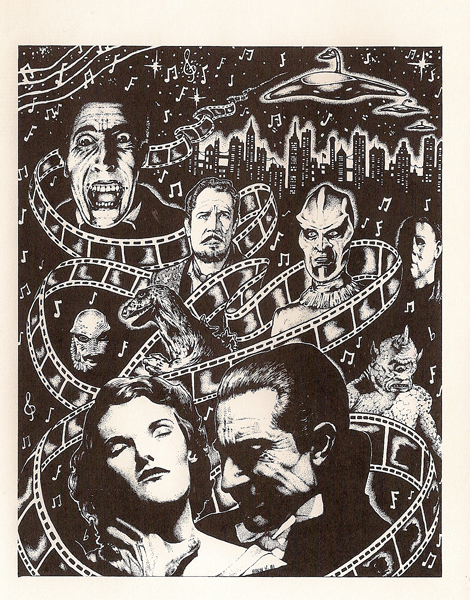March 25, 2021
Russian Anime: Scoring the SECRET MAGIC CONTROL AGENCY
An Interview with Gabriel Hays
by Randall D. Larson
The Secret Magic Control Agency sends its two best agents, Hansel and Gretel, to fight against the witch of the Gingerbread House.
Imagine grown-up Hansel and Gretel becoming top agents for the Department of Magical Security after escaping the Witch’s gingerbread house. That’s exactly what happens in SECRET MAGIC CONTROL AGENCY, now streaming on Netflix. The new Wizart Animation feature film merges the unlikely genres of “fantasy fairy tale” and “spy mystery,” which created unique challenges for composer Gabriel Hays to solve in the score. Whereas spy music is typically mysterious with serious swagger; the fantasy side of things typically feels more mystical, otherworldly, and epic. Hays pulled from both seemingly disparate genre traditions to compose the ideal score for the film. He found that both types of music shared some commonalities – a sense of uncertainty, but also adventure and discovery; themes which lent themselves well to this modern take on classic characters – full of fun, whimsy, and heart.
Gabriel Hays is a composer, songwriter and producer based in Los Angeles. Fascinated by blurring genres and twisting sounds, his music pulls on his experiences writing chamber music and playing in clubs. He loves combining elements of the orchestra with tactile soundscapes created by an ever-growing collection of synths, vintage instruments and processors. Gabriel has written for films, TV shows, and documentaries including HALF THE SKY (PBS), A PATH APPEARS (PBS) 7 DEADLY SINS (Showtime) and TRAVIS (Amazon) among many others; he has also contributed music to numerous animated series. Beyond music for media, Gabriel is a co-founder of the Images Salon series which had their debut concert featuring the fantastic Lyris Quartet on March 2, 2020 right before everything changed. Gabriel debuted his dynamic new piece there’s not even enough room to be anywhere. Originally from Santa Fe, NM, Gabriel has an MFA in composition from NYU and a BM from Denver’s Lamont School of Music.
For more information on the composer, see https://www.gabrielhays.com/
Q: What brought you into film music?
Gabriel Hays: Going all the way back, I would have to say that growing up I was always into music, just for its own sake. In high school I was really into drama, and before that I loved watching LOONEY TUNES and I was also partially pulled into it by the music of Carl Stalling and all that amazing world. I’ve had the STAR WARS movies and then Hitchcock movies, and I kept noticing the music, which I really felt added an extra element. So for me there was always this marriage of love for cinema and music that probably plays into it.
Q: What was your first score? What got you started?
Gabriel Hays: I tinkered around with it for a while. In high school I actually scored a play; I came up with an original score, so that would be like the first of the first, but obviously we’re not going to play that for anyone! I’m not sure there’s even a physical record of what was written for it. But I came to L.A. about nine years ago from New York, where I had been doing some short films and looking to find a leg into the field. When I came out here and I was lucky enough to have spend a little time out at Remote Control, just enough to help out on a couple of projects there. Then what I wound up doing was quite a bit of animation for television, mostly, and helped out on a few independent features. SECRET MAGIC CONTROL AGENCY was really my first feature, properly.
Q: You’d served as composer, co-composer, and additional music composer for a number of films and TV series throughout the 2000s; how did that serve as a learning experience for you as you gained more work in the scoring field?
Gabriel Hays: That was all super important, coming into it. I really started to focus on film scoring, which is a bit of a different art than composing in and of itself—and I felt I had a good handle as a composer on what I wanted to get to and what I wanted to write, and then just learning as much as I could—especially in the world of animation, which is where I found myself living mostly. It’s learning to see the drama and the story, and how you tell a story musically. One project I did recently was for Disney, a series of shorts called DISNEY AS TOLD BY EMOJI; they’re micro-retellings of the well-known Disney stories, and I did about fifteen of them. They’re all on Disney+ now. For example, they might have WALL-E, so how do you tell that story in four minutes when it’s just music and sound design. For me it was distilling the show down into the smallest form; how do I show that this is WALL-E and that Wall-E is sad or that Wall-E is excited, or Wall-E’s in danger. Sometimes you might have just a few beats in order to convey that information and then it moves on to the next story point. Those, in particular, it’s just the music and the sound design and the visuals that are telling the whole story, there’s no dialog to clue anything else in. That was one of the recent examples of just having to dig deep and figure that out.
Q: A few years back you scored the 2015 documentary TRAVIS: THE TRUE STORY OF TRAVIS WALTON, whose alleged alien abduction led to the 1973 film A FIRE IN THE SKY. What can you say about scoring this project?
Gabriel Hays: That was a fun project. It’s a documentary about Travis Walton and his experiences, so for anybody who has an interest in aliens and what may or may not have happened it’s definitely a fun and interesting watch to consider all of that. The music was pretty atmospheric, touching a little bit on the unknown was probably the driving force behind it, along with a fair amount of overall tension as well.
Q: You scored several other Disney animation TV projects in the mid 2000s. What were some of the scoring needs of the other shows like DISNEY STAR DARLINGS and WHISKER HAVEN TALES?
Gabriel Hays: The WHISKER HAVEN came about originally, and you may have noticed that this movie is co-credited with my long-time friend and collaborator, Brad Breeck. He’d been in this world for quite a while, and we go back a long ways. He needed a little help a number of years ago and asked me to come out, so I helped him out on a few things. In the case of STAR DARLINGS he actually recommended me to the filmmakers and so from there we tried things out and they checked out my music and made sure that it felt right, and I ended up that along with WHISKEY HAVEN with that same team.
Both shows are a series of shorts, although they did have a couple of longer episodes—but mostly it was a kind of collection. STAR DARLINGS is “Sparkle Princesses in Space!” That’s how the filmmakers described it to me, and that pretty much sums it up. There were a lot of pop-style cues and it also needed music that evoked a sense of space. To a certain degree with a lot of animation, you’re world building. You have these amazing visuals, along with dialogue and sound effects, too, but you have to help establish that we’re in space, and the music can help with things like that.
Q: How did you and Brad become involved with SECRET MAGIC CONTROL AGENCY?
Gabriel Hays: That’s an animated series as well. Brad and I were invited to submit for it, and they really liked what we did and invited us to do it. I guess it was just the right fit for us. For me I thought it fits in with the kind of musical sensibilities that I gravitate towards. I’ve always enjoyed fantasy, I grew up as a sci-fi and fantasy geek, so reading The Lord of the Rings when I was growing up, or a bit older with Harry Potter.
Sample the main theme from “SECRET MAGIC CONTROL AGENCY,” via Gabriel Hays’ YouTube page:
Q: How did you work with the filmmakers in the spotting and scoring process?
Gabriel Hays: They sent a script and then early cuts of the film so that we could get a sense of the story. After that we tried out a few ideas and realized that, in order to really find the story in it, we had to find the musical seeds, as it were—I would write some various melodic ideas, on piano usually, sometimes I would elaborate a bit more, and I would send them these various themes, and they might say “can we bring this one together with this one,” or “we like this part of this one.” So we would work back and forth until we felt what was right. The thing about this particular movie that was so interesting is because there’s the fantasy side of it—they’re Hansel and Gretel but they’re also secret agents, so we had to have a little bit of that swagger and mystique of the secret agents. That took a little while to figure out what that meant, from the musical point of view. If you look at, say, a James Bond movie, the music comes in and we all know what movie we’re watching. This obviously is not quite living in that big band jazz world so much, at least for the main characters, but it does have that swagger of them trying to solve a mystery. Things are very cool but there’s some trouble, but you know they’re going to pull it off. So there was little bit of that, a merger of these two worlds, the fantasy and the spy coming together.
Q: The characters of Hansel and Gretel, of course, have been known from folklore for centuries. How did you decide to handle these familiar characters, musically?
Gabriel Hays: At the end of the day there needed to be a few different themes in the movie, so it wasn’t so much a direct reference to their lineage as it was treating the characters as they are presented in this movie. There are some fun twists, and there’s Baba Yaga, who is the witch in the woods. Without giving anything away, there’s a very complicated but fun story that you just kind of stay attached to the whole way. They start off as adults and then through an accident they become kids again and they have to find the king who’s been abducted. So the music had a lot of territory to cover.
Q: How did you combine the fairy tale and spy mystery elements in your score?
Gabriel Hays: There’s the fun spy theme and then there’s another one that I consider to be the flip side, the serious side. There’s a theme that’s more about the adventure. It’s a very theme-heavy score. There’s a theme for the two of them as a team, where they connect in different ways and I might grab a little piece of one to show their friendship, and then another little piece of the other one to show that they’re on an assignment together, so it’s a little bit like using those little tidbits of themes at the right moments to show they’re onto the next big part of their chapter. There’s also motifs to relate how they came together as spies and how they’re going to solve the mystery in front of them.
Sample the track “Back at the SMCA” via Gabriel Hays’ YouTube page:
Q: What were the challenges of scoring this film, being produced in Russia, being both animated and in 3D? Were you able to see completed film or was some of that still in production when you came into the project?
Gabriel Hays: It was in different states, which is something that’s pretty common in any animated project I’ve worked on. You get some scenes that are basically complete, some that are in animatic, and then some that are still in almost a storyboard state, and various points in between. Usually between the dialogue and the visuals you see you get a pretty good sense of where things are going. We had pretty close to a locked cut early on; it did change here and there but not as much as a live action movie would change.
You mentioned the challenges of location—that was interesting! I felt like only in 2020 could we have a movie that was being written an produced in Russia but scored in Los Angeles, and then my orchestrator, Nicole Brady, had to go back to Australia when Covid happened, so she did the orchestrating from Australia, and then my mixer mixed the score in New York and we recorded the score in Budapest! For those recording sessions, today’s technology is pretty amazing. The folks in Budapest put us on a channel using software called Source Connect, so we were able to listen in high quality real time and have a microphone so we could talk with the conductor and the studio people, and have conversations back and forth while we’re working through everything. It worked really well.
Q: I’m impressed this project had a budget for an orchestra, as so many scores these days are done out of a box or digitally…
Gabriel Hays: Yeah. I’m a big believer in the magic of the live orchestra, and live players I general. Any time you can do that it really makes a difference. People don’t always know the difference until they hear a difference, so you might play them the same piece of music as it comes out of a computer, and it sounds pretty good, but then when you put it up played by an orchestra that’s playing well and mixed well, it’s a whole different world.
Sample the track “Here’s Looking at you not Kid” via Gabriel Hays’ YouTube page:
Q: Are there any plans for a soundtrack album of your score?
Gabriel Hays: We’re having some conversations back and forth about it. I don’t have an answer on that yet—I’m hoping so, of course!
Q: Can you say anything about any forthcoming projects?
Gabriel Hays: There’s nothing can say about film projects right now, but I am working on releasing some of my own original music. A year ago a lot of folks who ended up helping on this movie and I did a string quartet concert out here in L.A.—right before Covid hit we had this great concert on the 3rd of March and every one had a great time, and then suddenly a week later nobody was going anywhere. We worked with this wonderful group, the Lyris Quartet which is based out of Los Angeles. I have some plans to try and do some new recordings along those lines and hope to get those out this year.
Special thanks to Andrew Krop and Kyrie Hood of White Bear PR for facilitating this interview, and to Gabriel Hays for taking the time out to chat with me about these scores. -rdl
Watch the Netflix trailer for SECRET MAGIC CONTROL AGENCY:

